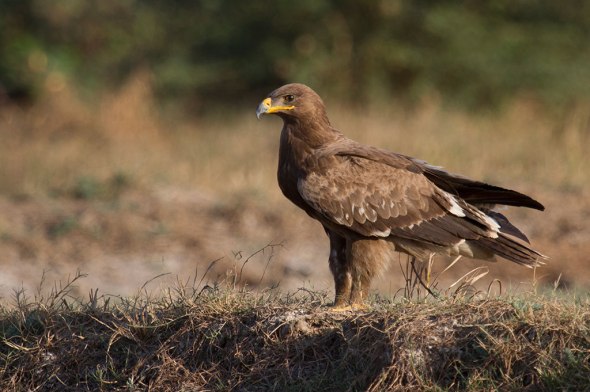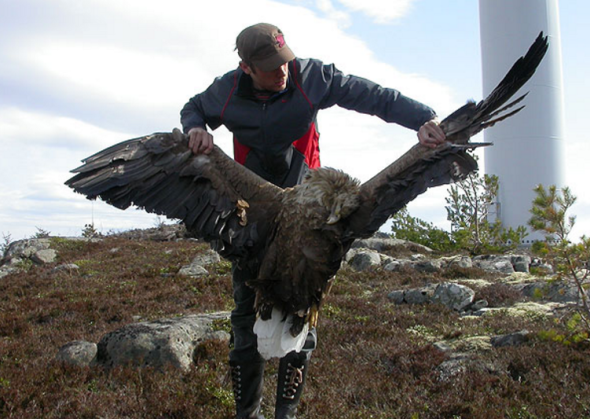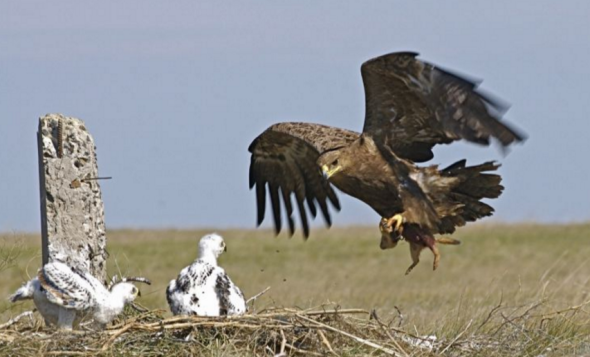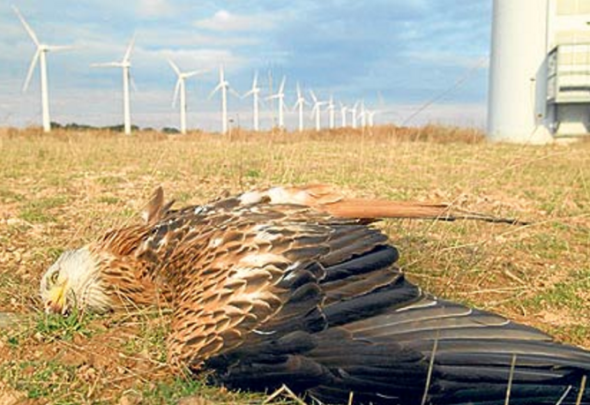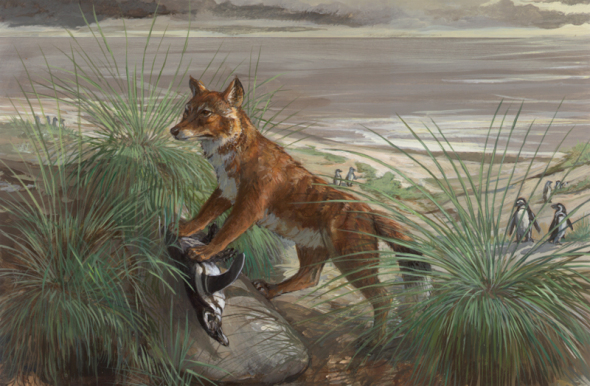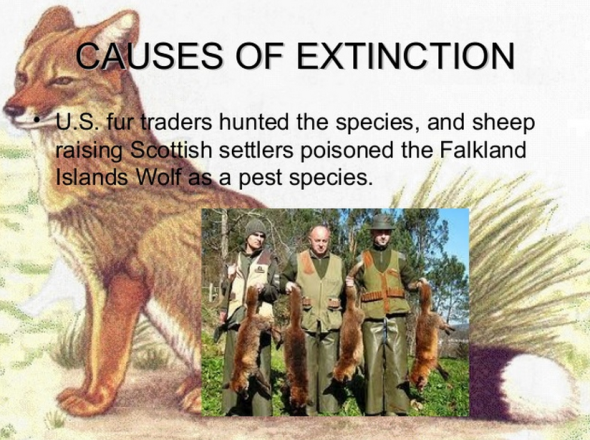Endangered Species Friday: Aquila nipalensis | Wind Farms Pushing Steppe Eagle into Extinction?
Endangered Species Friday: Aquila nipalensis
This Fridays (ESP) - Endangered Species Post is dedicated to the A. nipalensis, commonly known as the Steppe Eagle, identified back in 1833. Image credit: Kartik Patel
The Steppe Eagle was formally identified by Dr Brian Houghton Hodgson (1 February 1800 or more likely 1801 – 23 May 1894) was a pioneer naturalist and ethnologist working in India and Nepal where he was a British Resident. He described numerous species of birds and mammals from the Himalayas, and several birds were named after him by others such as Edward Blyth.
Dr Brian H. Hodgson was a scholar of Tibetan Buddhism and wrote extensively on a range of topics relating to linguistics and religion. He was an opponent of the British proposal to introduce English as the official medium of instruction in Indian schools. Had Dr H. Hodgson not introduced English into the many Indian schools, its very likely very few Indian citizens would today know how to speak the English language.
A. nipalensis is listed as (endangered), although its likely the predatory eagle will soon be relisted as (critically endangered), should conservation efforts not improve the current status of this remarkable bird of prey, however this particular bird is somewhat of a mystery.
The major reason why this species is listed as (endangered) which was only recently, is primarily due to wind farming of which birds are reported to fly directly into large structural turbines, which unfortunately, results in their death, or serious injury. Birds that are rescued suffering serious trauma are rarely released back into the wild, or make a full recovery.
From 1988 to 2000 the species was listed as (lower risk). Then from 2003 to 2014 the species remained at (least concern). A risk assessment conducted last year (2015), concluded that the species qualified for (endangered status). Which is somewhat concerning. To date we know the species has already been pushed into regional extinction in the countries identified as; Moldova and Romania. Today the species still remains endemic within the following countries;
Afghanistan; Albania; Armenia; Azerbaijan; Bahrain; Bangladesh; Bhutan; Botswana; Bulgaria; China; Congo; Djibouti; Egypt; Eritrea; Ethiopia; Georgia; Greece; India; Iran, Islamic Republic of; Iraq; Israel; Jordan; Kazakhstan; Kenya; Kuwait; Kyrgyzstan; Lebanon; Malawi; Malaysia; Mongolia; Myanmar; Namibia; Nepal; Oman; Pakistan; Palestinian Territory, Occupied; Qatar; Russian Federation; Rwanda; Saudi Arabia; Singapore; South Africa; South Sudan; Sudan; Swaziland; Syrian Arab Republic; Tajikistan; Tanzania, United Republic of; Thailand; Turkey; Turkmenistan; Uganda; Ukraine; United Arab Emirates; Uzbekistan; Viet Nam; Yemen; Zambia and finally Zimbabwe.
Aquila nipalensis is also a vagrant visitor to most of Northern Europe, Eastern Europe, South East Asia, Southern and Eastern Africa, ranging from Spain; Norway; France; Germany; Finland, Korea; Somalia; Slovakia Etc. Continued rate of decline is (unknown), which is concerning bird lovers and conservationists. Data recorded from the last assessment back in (2015), stated that populations are declining very rapidly.
Population Uncertainty
There seems to have been some perplexing information from the last assessment (before 2015’s) relating to population trend conducted we believe in (2010 or 2012). However the (2015) assessment has confirmed that the current population trend may stand at some: 100,000-499,999 (which is an estimate band or population band). Populations are not known to be (seriously fragmented). Surveys conducted back in (2001) placed the number of pairs at ‘80,000 pairs or 160,000 mature individuals’. Unfortunately the (European population) is estimated to be standing at 800-1,200 pairs in total.
Bird-Life International (2015) estimated that Europe holds the lowest population density standing at some 9%. So a very preliminary estimate of the global population size is 17,800-26,700 mature individuals. A further assessment back in (2001) relating to the European trend stated “160,000 mature individuals was much lower than previously believed”. So as one can see ‘population uncertainty’ is the second likely reason why the species has been re-listed as (endangered). Not forgetting being rather confusing at times too.
Latest Population Assessment Estimate
The latest, and most current population assessment estimate states numbers range (in total) at 31,372 (26,014-36,731) which equates to 62,744 (52,028-73,462) mature individuals or 94,116 (78,042-110,193) individuals. The population is placed in the band 100,000 to 499,999 mature individuals. It must be noted that 100,000 to 499,999 is not the true population count, but more the ‘band that the species currently stands at/qualifies for’.
Habitat destruction, agriculture, conversion of Steppe Eagle land for farming, persecutions, but most worrying is wind-farming that is “seriously threatening the species as we know it today”. Collisions with wind-turbines is quite a serious concern as the Steppe Eagle is not exactly a small bird, and when hunting, especially within converted land that hosts wind farms, Steppe Eagles are either killed or seriously injured to the point that they can never be rehabilitated back to the wild. Night collisions are reported more than day collisions.
Image: White tailed Eagle killed after colliding with a wind farm in the background.
The image above depicts a White Tailed Eagle that was located dead after a suspected collision with a wind turbine. As one can clearly see these Eagles are not small, nor are wind turbines. Unfortunately birds come off the worst as we humans crave more and more greener energy. The only real reasonable solution here would be to now lobby governments and industries to build wind farms away from ‘all bird habitat’, or at sea. Unfortunately, again this is easier said than done. While at sea wind turbines are being blamed for whale beaching’s due to turbine vibrations, meanwhile birds are mostly, sadly dying when hitting these gigantic steel/carbon structure’s.
Steppe Eagles migrate, and are said to be closely related to the subspecies Aquila rapax. Steppe Eagles are around 25-31 inches in length, with a mean wingspan of 5.1-7.1 feet. Females weigh 5-10 lbs, while males weigh in at around 4.4 to 7.7 lbs. Steppe Eagles are said to breed mainly from Romania of which the species is currently (regionally extinct) within the country. Further evaluation of breeding behavior states the species breeds in Central Asia, Mongolia to Africa, with further breeding occurring within Eastern Europe. Females lay on average 1-3 eggs within a clutch.
Image: Credited: Peter Romanow (Germany).
Major Threats
Listed on the (Convention of International trade in Endangered Species wild flora and fauna - Cites), Cites Appendix II. Threats are listed below for your information.
The species has declined in the west of its breeding range, including extirpation from Romania, Moldova and Ukraine, as a result of the conversion of steppes to agricultural land combined with direct persecution. It is also adversely affected by power lines and is very highly vulnerable to the impacts of potential wind energy developments. It was recently found to be the raptor most frequently electrocuted by power lines in a study in western Kazakhstan. When one views the sheer size of these massive birds of prey, one can clearly envisage just how easy they can fall prey to hitting these massive carbon wind structures, and power lines,
Young eagles are taken out of the nest in order to sell them to western European countries. A decline in the number of birds and a reduction in the proportion of juveniles migrating over Eilat, Israel began immediately after the Chernobyl nuclear accident in 1986, leading Yosef and Fornadari (2004) to suggest that the species may have been affected by radioactive contamination. This species is vulnerable to the veterinary drug Diclofenac too. Read more here on Chernobyl.
CONCERNING DATA ON CHERNOBYL AND LOW BIRD SPERM RATE: https://www.audubon.org/news/chernobyls-radiation-seems-be-robbing-birds-their-sperm
Wind Farming | Eagles
Wind energy is the fastest growing source of power worldwide according to the World Bank. China plans a 60% increase in the next three years and the US a six-fold jump by 2030. The EU aims to produce 20% of its energy through renewables by 2020 - much of this is from wind. Will this huge expansion of wind farms have a serious impact on bird life? It looks likely, especially where birds habitat is being encroached onto by such developments.
The U.S. Fish and Wildlife Service (FWS) estimates that 440,000 birds are killed in collisions with wind turbines each year; without stronger regulation, says the American Bird Conservancy (ABC), the annual toll will exceed one million by 2030. To address this issue, the U.S. Department of the Interior has released voluntary guidelines to help developers minimize the impact of wind energy projects on bird habitat and migration. Developed over five years with an advisory committee that included government agencies, the wind energy industry, and some conservation organizations, the guidelines are intended to ensure compliance with federal laws such as the Endangered Species Act—although the rules allowing them to do so are controversial.
Read more here: http://hqinfo.blogspot.co.uk/2012/11/bird-collision-deaths-wind-farms.html
Image: Red Kite killed found dead after colliding with a wind-turbine.
There are reasons why birds are likely to be affected by wind farms. Wind developments tend to be placed in upland areas with strong wind currents that have a lot of potential to generate energy. Birds – particularly raptors like eagles or vultures – use these currents as highways – and so are likely to come into contact with the turbines. It’s not just the turbine blades that pose a risk to birds; research indicates that wind developments can disrupt migration routes. What’s more, foraging and nesting habitat can also be lost when turbines are put up.
Despite these concerns, the current body of research suggests wind farms have not significantly reduced bird populations. Several studies suggest birds have the ability to detect wind turbines in time and change their flight path early enough to avoid them. And one small study found no evidence for sustained decline in two upland bird species on a wind farm site after it had been operating for three years. Another found that wild geese are able to avoid offshore wind turbines. (Geese though fly at daytime, and are not predatory day and nighttime carnivorousness hunters).
A large peer-reviewed study in the Journal of Ecology monitored data for ten different bird species across 18 wind farm sites in the UK. It found that two of them- curlew and snipe – saw a drop in population during the construction phase, which did not recover afterwards. But the population of the other eight species were restored once the wind farms were built.
Read more here: http://www.carbonbrief.org/bird-death-and-wind-turbines-a-look-at-the-evidence
The current fate relating to the Steppe Eagle is somewhat worrying. Agriculture, persecution, young theft for trade, and wind - turbine farming is all but concerning plundering the species into further threatened status. After reading many studies dating back to 2012 regarding wind turbines, and whether they were indeed responsible for bird deaths, 2012 evidence didn’t really show much to prove that birds were affected. However after reading the ‘damning evidence relating to the Steppe Eagle’, its without a doubt that wind farms are most certainly ‘impacting on this species and others’ locally and internationally. The question is how do we deal with this problem?
We need wind to generate more greener energy thus decreasing our carbon emissions. Furthermore we also need birds of prey to control rodent, insect, and general pest control. Large birds of prey are also very useful within Anti Poaching operations, and act as the eyes and ears for both farmers and anti poachers. While there is no evidence to prove my own suspicions here, I do believe that certain bodies within government are being forced to ignore ongoing issues with wind farms and bird collisions. The excuse that birds can quickly change course is indeed factual to some degree, well, only if the bird is flying during daytime hours. Unfortunately most birds of prey also fly and hunt at night. So how is one supposed to change their course (at nighttime when unable to see the turbine in time)?
Please view the videos below for more information.
BIRD OF PREY | TURBINE COLLISIONS
STEPPE EAGLE
Thank you for reading, please share and help create more noise about this subject before time runs out.
Dr Jose. C. Depre PhD. MEnvSc. BSc(Hons) Botany, PhD(NeuroSci) D.V.M.
Environmental, Botanical and Human Science
Endangered Species Friday [Case Study]: Dusicyon australis
Endangered Species Friday [Case Study]: Dusicyon australis
How the Fur Trade Pushed the Falkland Islands Wolf into Extinction.
This Friday’s Endangered Species watch Post (ESP) focuses on a species that was literally hunted into extinction. Daily I read comments about our wildlife or speak to animal lovers, activists or conservationists of which many show great concern in relation to legal hunting E.g (Cites permitted trophy hunting), or poaching E.g (non-permitted illegal hunting).
D. australis was identified back in 1792 as the (Falklands Wolf) by Dr Robert Kerr (1755 – 11 October 1813) was a scientific writer and translator from Scotland. Dr Kerr was born in Roxburghshire as the son of a jeweler. He studied medicine at the University of Edinburgh and practiced at the Edinburgh Foundling Hospital as a surgeon. He translated several scientific works into English, such as Antoine Lavoisier’s work of 1789, Traité Élémentaire de Chimie, published under the title Elements of Chemistry in a New Systematic Order containing All the Modern Discoveries, in 1790.
In 1792, Dr Kerr published The Animal Kingdom, the first two volumes of a four-tome translation of Professor Linnaeus’ Systema Naturae, which is often cited as the taxonomic authority for a great many species. (He never did the remaining two volumes.) What would Dr Kerr say now if he knew this magnificent creature he discovered has since been pushed into extinction via ‘legal hunting practices and deliberate persecution’?. Like few conservationists and philanthropist’s that I have spoken to whom have identified species of birds, frogs and new world primates their most common reaction is utter shock and frustration, although most were not surprised.
While Dr Kerr was the primary individual that named and listed the species, Capt. John Strong, a British Marine explorer was the very first person to discover the Falkland Island Wolf upon landing on the Falkland Islands back in the 1690’s. Based on historical and fossil records we know the species was living quite a peaceful and undisturbed life. Historical records also prove that Charles Darwin who was a naturalist and geologist whom visited the islands back in 1833 stated the Falkland’s Wolf was commonly seen. Its from this point back in the early 1800’s after Charles Darwin’s visit that the Falkland Wolf populations began to decline. Within approximately thirty years after Charles Darwin’s visit - the species then went extinct.
From 1833 to 1876 when active exploration’s and colonization’s began increasing the evidence pinpoints that humans were the primary cause for the species complete extinction. Had the Falkland’s not been colonized or disturbed by explorers and hunters its very likely the Falkland Islands Wolf would still be with us today. That is based on my own expert opinion and scientific studies that have proved islands with no human interference over eighty million years old up to the 1900’s the majority of non-colonized islands regardless of their size - all their natural wildlife discovered is still mostly intact. Take the island of Madagascar as an example!
The prehistoric breakup of the supercontinent Gondwana separated the Madagascar-Antarctica-India landmass from the Africa-South America landmass around 135 million years ago. Madagascar later split from India about 88 million years ago, allowing plants and animals on the island to evolve in relative isolation. As a result of the island’s long isolation from neighboring continents, Madagascar is home to an abundance of plants and animals found nowhere else on Earth. Approximately 90 percent of all plant and animal species found in Madagascar are endemic. So we know that if left untouched both the Falkland island and Madagascar’s habitat and wildlife both flora and fauna lived undistributed.
While Madagascar’s history is a little different from the Falkland Islands the evidence is clear, that as soon as explorers, human colonies, immigrants and travelling settlers visited - the habitat became threatened just as the Falkland’s Wolf became extinct in under thirty years after Charles Darwin’s visit, 1833. Only 10 percent of Madagascar’s forests now remain. Also, recent estimates suggest that 1-2 percent of Madagascar’s remaining forests are destroyed each year, and that a staggering 80-90 percent of Madagascar’s land area burns each year. Ninety percent of Madagascar’s Lemurs are moving towards complete extinction - and why? from 700 CE – 1500 when immigrants, traders and explorers arrived - wildlife and habitat began to decline gargantuanly. However based on historical fur trade records a pattern has emerged - its concerning - its continuing - and if not banned its likely other animals will suffer due to the fur trade.
“Our ancestors are not to blame”
But lets not jump the gun here blaming our own ancestors for the primary decline of wildlife and destruction of habitat. As Charles Darwin explained in the 1830’s on visiting the Malvina the Falkland Wolf was still quite commonly seen. Just as Lemurs and forest remained intact on the island of Madagascar before humans arrived, history tells us though that our ancestors mostly respected the land and wildlife however, its from years of 1800 that wildlife and habitat began declining. The Falkland’s Wolf wasn’t killed off by our ancestors as such but more - US fur traders from the 1830s, and when Scottish settlers arrived in the 1860s began raising sheep on the Island, D. australis was poisoned as a pest species too.
Is it just a mere coincidence that the Falkland Islands Wolf went extinct as soon as the fur trade began booming from the 1600’s to the 1800’s dare I ask? commercial fur trade in North America grew out of the early contact between Indians and European fisherman who were netting cod on the Grand Banks off Newfoundland and on the Bay of Gaspé near Quebec. Indians would trade the pelts of small animals, such as mink, for knives and other iron-based products, or for textiles. Exchange at first was haphazard and it was only in the late sixteenth century, when the wearing of beaver hats became fashionable, that firms were established who dealt exclusively in furs. The trade then spread to America thus seeing United States citizens hunting the Falklands Wolf into extinction. So again I question is it correct to blame our ancestors whom colonized the Falkland Islands of which Darwin stated the wolf was still commonly seen from 1830, bur more blame Canadians, Americans and Europeans for the introduction of the fur trade? That’s the problem, not colonization or immigration but sheer commercialization of an animal trade and greed.
There are some other factors of course that relate to the Falkland’s Wolf extinction. The species natural prey which was rodents were in decline too. Due to the decline of certain prey specimens this unfortunately forced the wolf into now human populated agricultural lands, hunting sheep. The Falkland’s Wolf was then seen as a pest of which settlers, mainly farmers deliberately laid poisoned traps thus decreasing populations furthermore. Its believed that the decline in rodents was primarily due to humans protecting their farms and crops. None knows for sure the entire Falkland’s Wolf diet but - ground-nesting birds such as geese and penguins, grubs and insects, as well as seashore scavenging would most likely have been common prey and foraging behavior.
Conclusion:
The Falkland’s Wolf was killed off by greed, legal hunting and the fur trade. Its quite sad to know that after Darwin’s notes were made public the species soon became extinct some thirty years later, had them notes not been publicized - the species could still be with extant. While we have certain protocols, laws and agreements in place such as the Convention on International Trade of Endangered Species (Cites), and the International Union for the Conservation of Nature - history is still repeating itself, so I do at the best of times question why we have such organisations in place to protect wildlife - when its “we humans” that should be taking the stand and protecting what is left on Planet Earth. While poaching remains a significantly large threat to many large fauna such as Lions, Elephants, Rhino and aquatic wildlife. The agricultural trade, indiscriminate hunting and habitat loss remains the number one threat to all species of flora and fauna.
So, how do we stop further extinctions and declines of wildlife? Well if you’ve read this entire article all the way through (the answer is in front of you).. You’ve just got to open your eyes, absorb the information and act on it.
Dr Jose C. Depre.
Environmental and Botanical Science.

